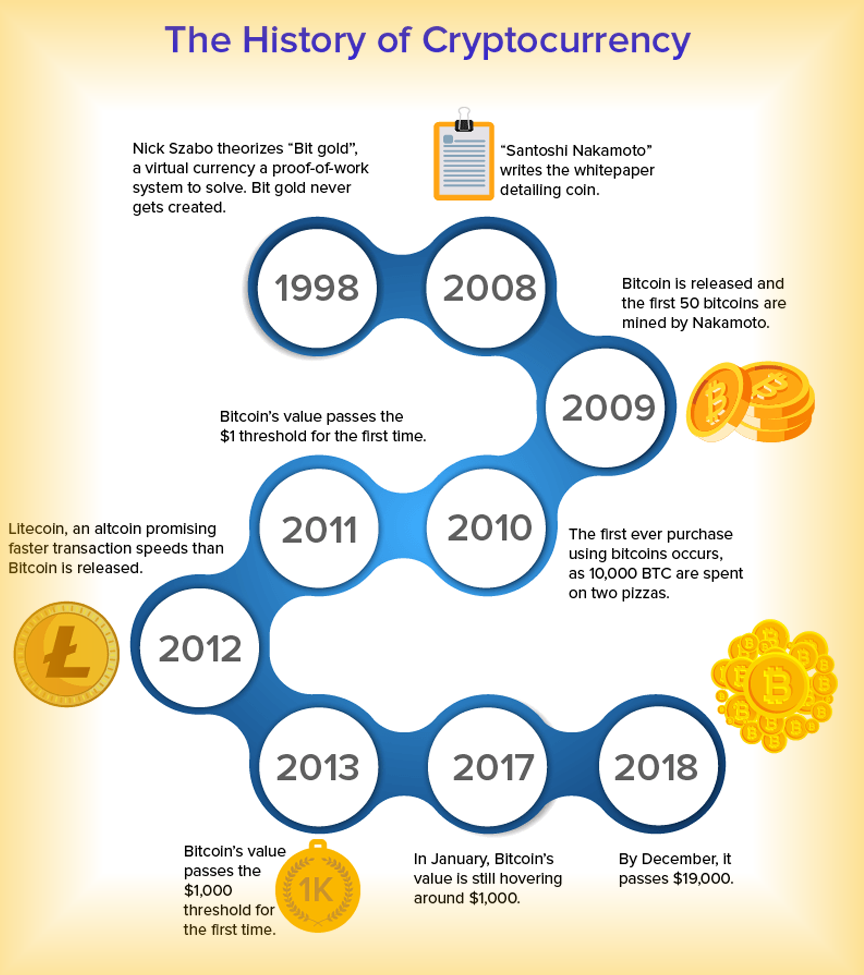HISTORY OF CRYPTO
Although it's often referred to as new.....
Bitcoinhas existed since 2009 and the technology it is built on has roots going back even further.
In fact if you had invested just $1,000 in Bitcoin the year it was first publicly available, you would now be richer to the tune of £36.7 million.

1998 – 2009
THE PRE-BITCOIN YEAR
Although Bitcoin was the first established cryptocurrency, there had been previous attempts at creating online currencies with ledgers secured by encryption. Two examples of these were B-Money and Bit Gold, which were formulated but never fully developed.
B-MONEY
- First revealed in 1998 by computer scientist Wei Dai, b-money was intended to be an anonymous, distributed electronic cash system.
- Although it was never officially launched, b-money endeavoured to provide many of the same services and features that contemporary cryptocurrencies today do as well.
- Wei Dai, a computer engineer and graduate of the University of Washington, published an essay in 1998 introducing the concept of b-money.
BIT-GOLD
- Bit gold was one of the earliest attempts at creating a decentralized virtual currency, proposed by blockchain pioneer Nick Szabo in 1998.
- Although the bit gold project was never implemented, Szabo's attempt is widely considered to be the precursor to Satoshi Nakamoto’s bitcoin protocol.
- Bit gold combines different elements of cryptography and mining to accomplish decentralization, including time-stamped blocks that are stored in a title registry and are generated using proof-of-work (PoW) strings.
2008
THE MYSTERIOUS MR. NAKAMOTO
A paper called Bitcoin – A Peer to Peer Electronic Cash System was posted to a mailing list discussion on cryptography. It was posted by someone calling themselves Satoshi Nakamoto, whose real identity remains a mystery to this day.
2009
BITCOIN BEGINS
The Bitcoin software is made available to the public for the first time and mining – the process through which new Bitcoins are created and transactions are recorded and verified on the blockchain – begins.
2010
BITCOIN BEGINS
As it had never been traded, only mined, it was impossible to assign a monetary value to the units of the emerging cryptocurrency. In 2010, someone decided to sell theirs for the first time – swapping 10,000 of them for two pizzas. If the buyer had hung onto those Bitcoins, at today’s prices they would be worth more than $100 million.
2011
RIVAL CRYPTOCURRENCIES EMERGE
As Bitcoin increases in popularity and the idea of decentralized and encrypted currencies catch on, the first alternative cryptocurrencies appear. These are sometimes known as altcoin and generally try to improve on the original Bitcoin design by offering greater speed, anonymity or some other advantage. Among the first to emerge were Namecoin and Litecoin. Currently there are over 1,000 cryptocurrencies in circulation with new ones frequently appearing.
2013
BITCOIN PRICE CRASHES
Shortly after the price of one Bitcoin reaches $1,000 for the first time, the price quickly begins to decline. Many who invested money at this point will have suffered losses as the price plummeted to around $300 – it would be more than two years before it reached $1,000 again.
2014
SCAMS AND THEFT
Perhaps unsurprisingly for a currency designed with anonymity and lack of control in mind, Bitcoin has proven to be an attractive and lucrative target for criminals. In January 2014, the world’s largest Bitcoin exchange Mt.Gox went offline, and the owners of 850,000 Bitcoins never saw them again. Investigations are still trying to get to the bottom of exactly what happened but whatever the story, someone dishonestly got their hands on a haul which at the time was valued at $450 million dollars. At today’s prices, those missing coins would be worth $4.4 billion.
2016
ETHEREUM AND ICOs
One cryptocurrency came close to stealing Bitcoin’s thunder this year, as enthusiasm grew around the Ethereum platform.
This platform uses cryptocurrency known as Ether to facilitate blockchain-based smart contracts and apps. Ethereum’s arrival was marked by the emergence of Initial Coin Offerings (ICOs). These are fundraising platforms which offer investors the chance to trade what are often essentially stocks or shares in startup ventures, in the same manner that they can invest and trade cryptocurrencies. In the US the SEC warned investors that due to the lack of oversight ICOs could easily be scams or ponzi schemes disguised as legitimate investments. The Chinese government went one further, by banning them outright.
2017
BITCOIN REACHES $10,000 and CONTINUES TO GROW
A gradual increase in the places where Bitcoin could be spent contributed to its continued growth in popularity, during a period where it’s value remained below previous peaks. Gradually as more and more uses emerged, it became clear that more money was flowing into the Bitcoin and cryptocoin ecosystem. During this period the market cap of all cryptocoins rose from $11bn to its current height of over $300bn. Banks including Barclays, Citi Bank, Deutsche Bankand BNP Paribas have said they are investigating ways they might be able to work with Bitcoin. Meanwhile the technology behind Bitcoin – blockchain – has sparked a revolution in the fintech industry (and beyond) which is only just getting started. Whatever your opinion on Bitcoin and cryptocurrency – and educated commenters have described them as everything from the future of money to an outright scam – it seems they are here to stay
2016 - 2018
Bitcoin prices rose steadily year over year, going from $434 in January 2016, to $998 in January 2017. In July 2017, a software upgrade to Bitcoin was approved, with the aim being to support development of the Lightning Network (a layer-two scaling solution) as well as improve security.
A week after the upgrade was activated in August, Bitcoin was trading at around $2,700. By December 17, 2017, Bitcoin reached an astronomical all-time high of just under $20,000.
During this same time, a new blockchain project called Ethereum was making noise in the cryptocurrency sphere, having quickly become the number two cryptocurrency by market cap since launching in July 2015. It brought smart contracts to cryptocurrency, opening a wide array of potential use cases and generating over 200,000 different projects (and counting). In contrast to Bitcoin, Ethereum enables additional platforms to launch and operate on its own chain, each with their own cryptocurrencies and their own use cases. This was a model widely copied by other new blockchains, with Cardano, Tezos and Neo (to name only three) launched during this period.

2018-PRESENT
Bitcoin was not able to sustain its all-time high of $19,783. Likewise, Ethereum, which reached its own ATH in January 2018 of around $1,400, was also not able to maintain its newfound level for long. Financial regulations and security concerns (due to semi-regular exchange hacks) contributed to the market-wide decline, and by the end of 2018 bitcoin had dropped down to around $3,700.
However, prices didn’t stay down for too long. Starting from late 2020, bitcoin enjoyed something of a renaissance, beginning with (“business intelligence company”) MicroStrategy’s announcement in August that it had bought bitcoin worth $250 million. This kicked off a bull market that was joined by the rest of the market, with prices boosted further by Tesla’s purchase of $1.5 billion in bitcoin in early 2021. It was in November of that year that bitcoin reached its current record high of $69,000.
The market has fallen once again since this high, dragged down by macroeconomic concerns resulting from high inflation, rising interest rates and the specter of war. That said, with global stock markets also falling in late 2021 and 2022, crypto’s parallel fall shows that the sector is becoming increasingly entwined with traditional financial markets.
And while the volatility of cryptocurrencies is both attractive and potentially devastating, the underlying technology behind them all, blockchain, has the power to change many sectors of our society. Whether it’s providing accessible and affordable financial exchange options, securing your own funds so that no one but you can access them, or providing accurate data for your insurance quote, blockchain technology has the potential to be used in almost every area of the economy.
As the market becomes more stable with increased knowledge, and with the introduction of new areas such as stablecoins and decentralized finance (DeFi), it’s easy to get excited about cryptocurrency and its potential from an investment and technological perspective. This is regardless of whether it’s Bitcoin or another blockchain project that stokes your interest.
